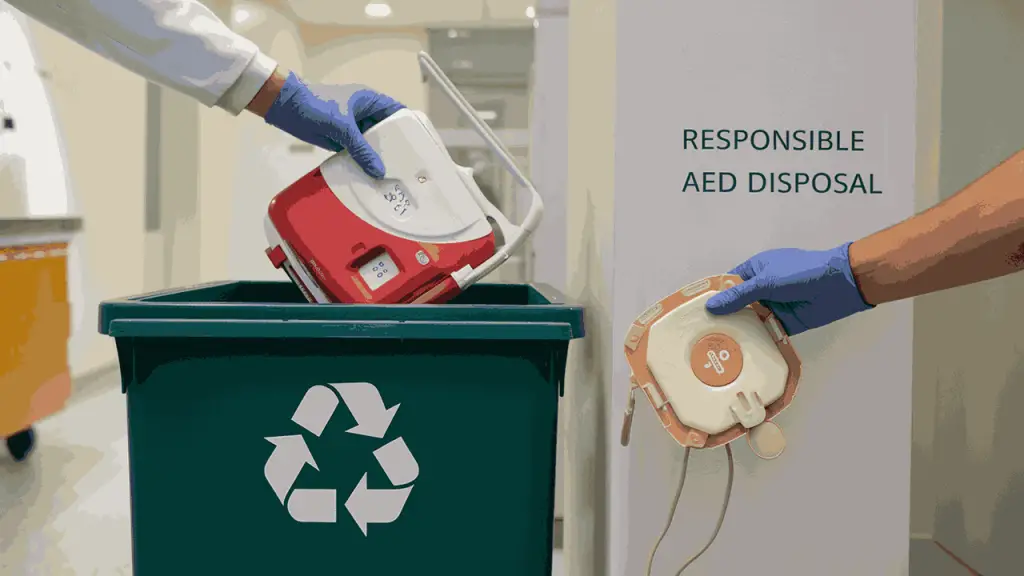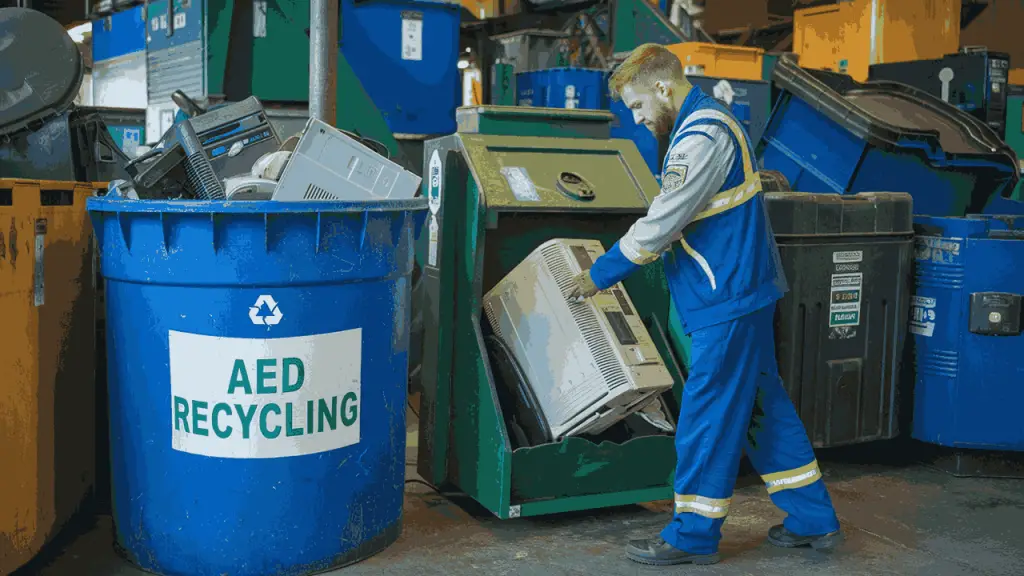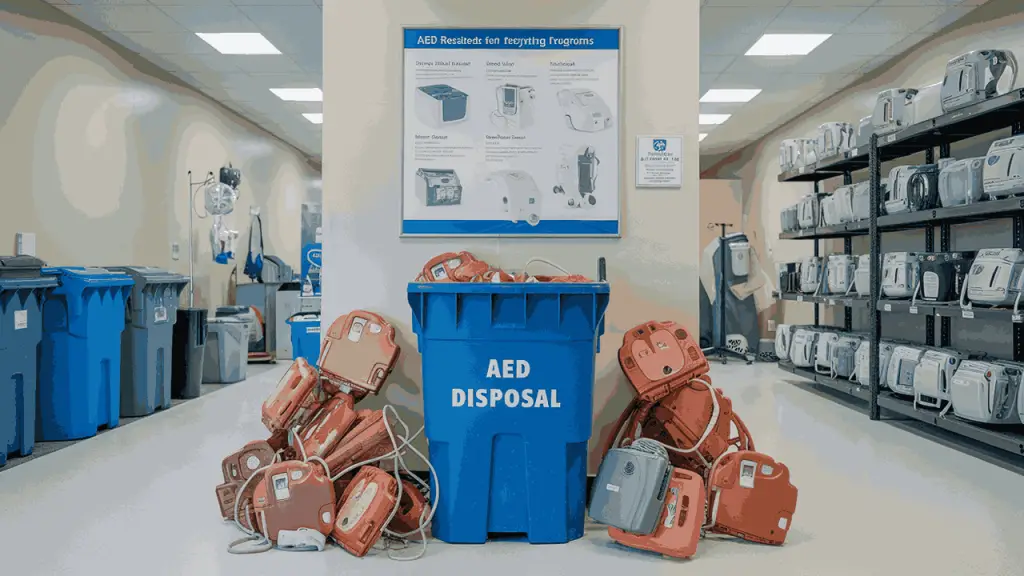Your old AED might look like it’s past its prime, but dumping it carelessly can be risky. Its batteries and electronics can hurt both people and the environment. This guide will help you learn how to dispose of old AED safely and even recycle it.

Understanding AED Lifespan and Maintenance
A. Typical AED lifespan (5-15 years)
When you invest in an Automated External Defibrillator (AED), it’s essential to understand its lifespan. Typically, AEDs have a functional life of 5-15 years, depending on the brand and model.
However, this doesn’t mean your device will automatically expire after this period. With proper maintenance and regular component replacements, you can ensure your AED remains operational for an extended time.
| Component | Typical Lifespan |
| AED Unit | 5-15 years |
| Battery | Over 5 years |
| Electrode Pads | 2-5 years |
B. Importance of regular checks and expiration dates
To keep your AED in top condition, you should perform regular checks and be aware of expiration dates. Here’s what you need to do:
- Conduct monthly visual inspections
- Check status indicators regularly
- Verify battery installation and functionality
- Inspect for physical damage
- Ensure availability of unexpired pads
- Follow manufacturer’s maintenance guidelines
Remember, some states mandate even more frequent checks, so it’s crucial to familiarize yourself with local regulations. You should also document your maintenance efforts to comply with these regulations.
C. Consequences of malfunctioning AEDs
A malfunctioning AED can have serious consequences in emergency situations. Imagine a scenario where a coworker collapses, and you rush to use the AED, only to find it has dead batteries. This could mean the difference between life and death. To avoid such critical failures:
- Store your AED in a visible, unobstructed location
- Keep it about four feet off the ground for easy access
- Use temperature-controlled cabinets for outdoor storage
- Clean and disinfect the AED carefully after each use
- Monitor expiration dates of pads and batteries closely
By following these guidelines, you’ll ensure your AED is always ready for use when needed most.
Now that we’ve covered the essentials of AED lifespan and maintenance, let’s move on to the next crucial topic i.e. Proper Disposal of AED Components. This section will guide you through the correct procedures for disposing of your old AED and its parts, ensuring both safety and environmental responsibility.
Proper Disposal of AED Components

A. Disposing of AED pads
When it comes to disposing of AED pads, you have several options:
- Regular trash: AED pads are typically made from non-hazardous materials and can be discarded in regular trash without special handling.
- Electronics recycling: Take expired pads to accredited electronics recycling facilities or participate in local electronic waste recycling programs.
- Contaminated pads: If the pads are contaminated, consult an infectious waste management company for proper disposal.
Remember to dispose of expired pads promptly to prevent misuse, as dried conductive gel can render them ineffective.
B. Recycling AED batteries
AED batteries require special attention due to their hazardous nature:
- Recycling programs: Utilize designated battery recycling programs or contact hazardous waste providers for proper disposal.
- Safety precautions: Ship batteries using ground transportation to prevent fire hazards.
- Regular checks: Perform routine inspections to identify and replace expired batteries, as they can lead to dangerous situations like leaks and fires.
| Battery Type | Disposal Method |
| Lithium-ion | Local electronic recycling centers or certified retailers |
| Other types | Manufacturer recycling programs or hazardous waste facilities |
C. Handling the AED device itself
When disposing of the AED device:
- Consult authorized facilities for proper recycling methods.
- Consider manufacturer recycling programs or certified electronic recycling centers.
- Never throw the device in regular trash due to its electronic components.
You can also explore national recycling programs such as the Cardiac Life Recycle Program and Call 2 Recycle for AED device disposal.
Keeping these in mind, you’re all set to dispose of your AED responsibly. And if you’ve got other medical stuff piling up, like pill bottles or sharps containers, we’ve got guides for those too! Check out How to Recycle Pill Bottles and How to Dispose of Sharps Containers for more easy tips on keeping medical waste out of landfills.
Environmental and Health Considerations
Now that we’ve covered proper disposal of AED components, let’s explore the environmental and health considerations associated with AED disposal.
A. Risks of improper AED disposal
Improper disposal of AEDs can release toxic substances into the environment, endangering wildlife and human health. You should be aware that batteries and electronic components in AEDs can contaminate soil and water if not disposed of correctly.
B. Hazardous materials in AEDs
AED batteries contain hazardous materials, including:
| Material | Environmental Impact |
| Mercury | Soil contamination |
| Lead | Water pollution |
| Cadmium | Atmospheric pollution |
AED Recycling Programs and Options

Now that we’ve explored the environmental and health considerations of AED disposal, let’s explore various recycling programs and options available to you for safely disposing of your old AED.
A. Manufacturer Recycling Programs
Many AED manufacturers offer recycling programs to help you dispose of your outdated devices responsibly. These programs often include:
- Free recycling services for AEDs, batteries, and electrode pads
- Acceptance of multiple AED brands
- Specific guidelines for packaging and shipping
To participate in a manufacturer’s recycling program, you’ll typically need to:
- Contact the manufacturer or their authorized recycling partner
- Follow their instructions for preparing your AED for shipment
- Print and attach a return address label
- Ship the device at your own cost
| Advantages | Considerations |
| No processing or disposal fees | Shipping costs are your responsibility |
| Environmentally responsible | May require agreement to terms and conditions |
| Accepts various AED components | Specific packaging requirements |
B. Certified Electronic Recycling Centers
If a manufacturer program isn’t available, you can turn to certified electronic recycling centers. These facilities specialize in handling electronic waste, including AEDs. Here’s what you need to know:
- They follow state and federal guidelines for proper disposal
- Can handle the electronic components like circuit boards
- May offer additional services for battery recycling
For example, Electronic Recyclers International (ERI) is e-Stewards certified with facilities across the US; Sims Lifecycle Services holds R2v3 certification with a focus on sustainability and data security; and Cascade Asset Management is also e-Stewards certified, specifically handling medical equipment recycling.
You can also use directories like e-Stewards Find a Recycler or R2 Certified Facilities to locate more options near you.
C. Local Recycling Options for Batteries and Devices
Your local community might offer recycling options for AEDs and their components:
- AED Units: Look for electronic waste collection events or permanent drop-off locations in your area.
- Batteries:
- Non-rechargeable AED batteries are considered hazardous waste due to their lithium content.
- Some facilities offer special recycling or re-celling processes for these batteries.
- Electrodes and Pads:
- Adult and child electrodes often contain components that shouldn’t be landfilled.
- Pediatric electrodes may have attenuators with circuit boards requiring special handling.
With these recycling programs and options in mind, next, we’ll explore the specific guidelines for safe AED disposal to ensure you follow the correct procedures when retiring your device.
Guidelines for Safe AED Disposal
A. Isolation of battery packs
You should always remove and isolate AED battery packs before disposal. These contain hazardous lithium-sulfur dioxide and must be recycled separately to prevent fire hazards.
B. Proper packaging for shipping
When shipping AED components:
- Use ground transportation for batteries
- Pack devices securely to protect electronic components
- Label packages clearly as “AED for recycling“
C. Adhering to state and federal regulations
| Regulation Type | Action Required |
| Federal | Research national disposal guidelines |
| State | Check local recycling programs |
| Local | Contact authorized facilities for guidance |
You must comply with all applicable regulations to avoid fines and ensure responsible disposal.
Resources for AED Recycling and Replacement

Now that we’ve covered the guidelines for safe AED disposal, let’s explore the various resources available for AED recycling and replacement. This information will help you responsibly manage your old AEDs while ensuring you have access to functional devices when needed.
A. Contacting local emergency services
You can reach out to your local emergency services for guidance on AED recycling and replacement. They often have valuable information about:
- Local recycling programs
- Proper disposal methods
- Potential partnerships with healthcare facilities
By contacting them, you’ll gain insights into region-specific regulations and resources that can assist you in responsibly managing your old AEDs.
B. Utilizing national recycling programs
Several national programs offer convenient solutions for recycling your old AEDs:
- AED One-Stop Shop’s Free AED Recycling Program:
- Request enrollment
- Receive a prepaid shipping label
- Package and ship your AEDs
- They’ll dismantle and recycle the devices responsibly
- Coro Medical’s free battery recycling service:
- Follow specific guidelines for shipping
- Fully discharge batteries before sending
- Ensure batteries don’t touch during transit
| Program | Accepts | Shipping Costs |
| AED One-Stop Shop | AEDs, batteries, electrode pads | Free (prepaid label) |
| Coro Medical | AED batteries | Customer responsibility |
C. Consulting AED manufacturers and providers
You can also reach out to AED manufacturers and providers for recycling and replacement options:
For example, Think Safe:
- Offers an AED Recycling and Trade-In Program
- Provides credits towards future purchases
- Offers “Re-Cell” battery service for recycling battery housings
By utilizing these resources, you’ll ensure proper disposal of your old AEDs while staying compliant with regulations and maintaining functional devices for emergencies.

